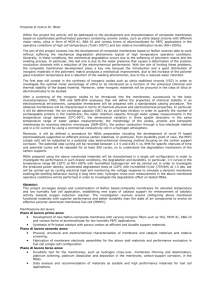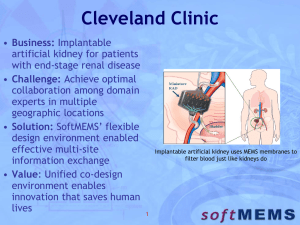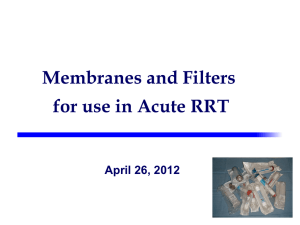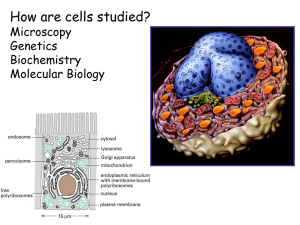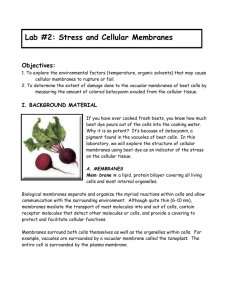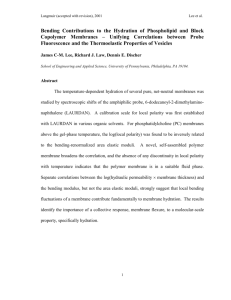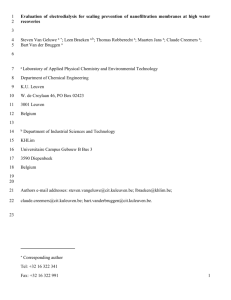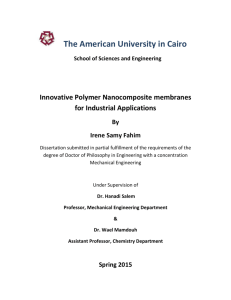OK studied chemistry at the Hebrew University in Jerusalem
advertisement
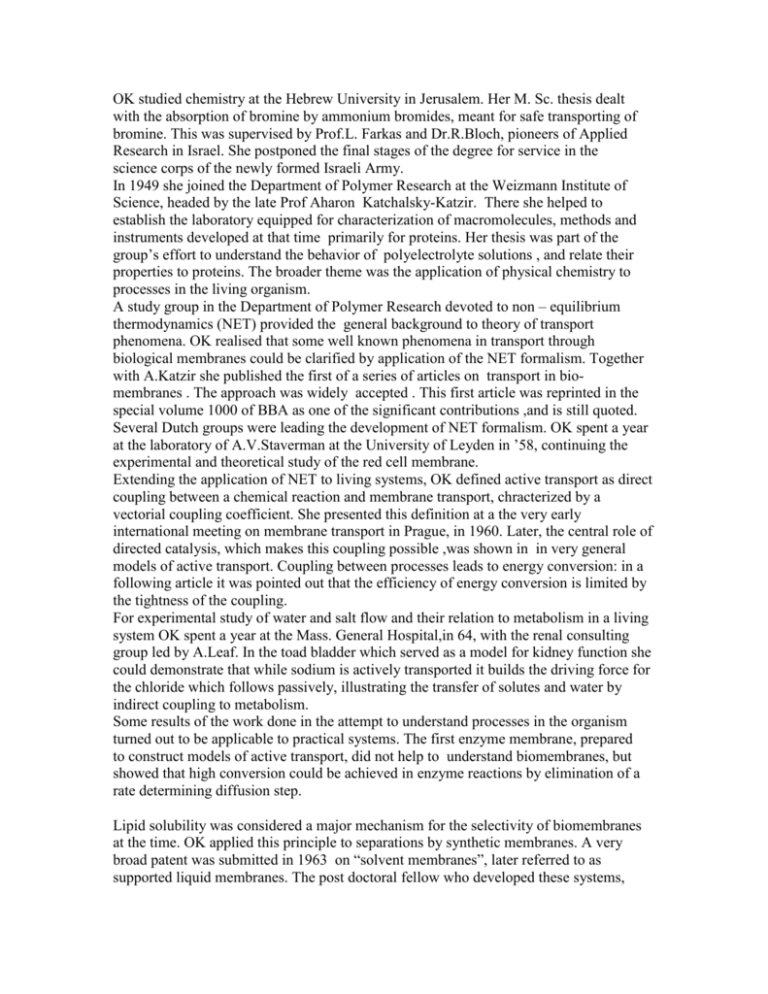
OK studied chemistry at the Hebrew University in Jerusalem. Her M. Sc. thesis dealt with the absorption of bromine by ammonium bromides, meant for safe transporting of bromine. This was supervised by Prof.L. Farkas and Dr.R.Bloch, pioneers of Applied Research in Israel. She postponed the final stages of the degree for service in the science corps of the newly formed Israeli Army. In 1949 she joined the Department of Polymer Research at the Weizmann Institute of Science, headed by the late Prof Aharon Katchalsky-Katzir. There she helped to establish the laboratory equipped for characterization of macromolecules, methods and instruments developed at that time primarily for proteins. Her thesis was part of the group’s effort to understand the behavior of polyelectrolyte solutions , and relate their properties to proteins. The broader theme was the application of physical chemistry to processes in the living organism. A study group in the Department of Polymer Research devoted to non – equilibrium thermodynamics (NET) provided the general background to theory of transport phenomena. OK realised that some well known phenomena in transport through biological membranes could be clarified by application of the NET formalism. Together with A.Katzir she published the first of a series of articles on transport in biomembranes . The approach was widely accepted . This first article was reprinted in the special volume 1000 of BBA as one of the significant contributions ,and is still quoted. Several Dutch groups were leading the development of NET formalism. OK spent a year at the laboratory of A.V.Staverman at the University of Leyden in ’58, continuing the experimental and theoretical study of the red cell membrane. Extending the application of NET to living systems, OK defined active transport as direct coupling between a chemical reaction and membrane transport, chracterized by a vectorial coupling coefficient. She presented this definition at a the very early international meeting on membrane transport in Prague, in 1960. Later, the central role of directed catalysis, which makes this coupling possible ,was shown in in very general models of active transport. Coupling between processes leads to energy conversion: in a following article it was pointed out that the efficiency of energy conversion is limited by the tightness of the coupling. For experimental study of water and salt flow and their relation to metabolism in a living system OK spent a year at the Mass. General Hospital,in 64, with the renal consulting group led by A.Leaf. In the toad bladder which served as a model for kidney function she could demonstrate that while sodium is actively transported it builds the driving force for the chloride which follows passively, illustrating the transfer of solutes and water by indirect coupling to metabolism. Some results of the work done in the attempt to understand processes in the organism turned out to be applicable to practical systems. The first enzyme membrane, prepared to construct models of active transport, did not help to understand biomembranes, but showed that high conversion could be achieved in enzyme reactions by elimination of a rate determining diffusion step. Lipid solubility was considered a major mechanism for the selectivity of biomembranes at the time. OK applied this principle to separations by synthetic membranes. A very broad patent was submitted in 1963 on “solvent membranes”, later referred to as supported liquid membranes. The post doctoral fellow who developed these systems, R.Bloch, prepared a calcium specific, complexing, solvent membrane as the basis for a measuring method. Ion specific electrodes for a variety of species based on this principle were later developed and commercialised by several groups. OK consulted with Research Products Rehovoth,a company founded by R.Bloch. Applications of charged membranes, solvent membranes, enzyme membranes and electrodialysis were developed in cooperation with European Industry. In 75 she worked at the company (reorganized and called Membrane Products Weizmann) full time as Scientific Director. MPW produced stable membranes in the selectivity region between RO and UF in the 70’s , before “nanofiltration” became an accepted and important process. The MPW membranes were used in industry for concentration of dyes and similar solutes and removal of salts from the solutions, exploiting negative salt rejection. MPW was later sold to an American company which includes the stable nanofiltration membranes in their products. In the late 60’s OK became interested in desalination . Flow equations based on the earlier analysis were adapted to the conditions of reverse osmosis, in cooperation with the late Sam Spiegler. His work on the use friction coefficients in the modeling of membrane permeation had earlier been developed by Kedem amd Katchalsky for the interpretation of pressure driven flow. Theoretical and experimental work on charged membranes, carried out with the support of OSW, showed separations possible in “hyperfiltration” of mixed electrolyte solutions,. A general description of flows in composite membranes included mosaic membranes. The calculation of the interaction between salt and water flows in such structures led to prediction of salt enrichment in the filtrate , later termed piezodialysis. Polarization in electrodialysis and phenomena caused by it were analyzed. Electrodialysis would be an effective economic process for the desalination of low salinity water, if its output were not limited by polarization. Suitably formed ion exchange spacers were suggested as a solution to this problem. It was shown theoretically and experimentally that polarization can indeed be suppressed by the conducting spacers. In 67/8 OK spent a year in Beer-Sheva, working at the Nuclear Research Center Negev, organizinge courses and teaching in the Institute for Higher Education in Beer-Sheva,. This Institute became the nucleus of the University of Beer-Sheva, at present the Ben Gurion University of the Negev. In 1973 Aharon Katzir was killed in a terror attack . With support and encouragement from the international scientific community OK founded and chaired for a number of years the department of membrane research at the Weizmann Institute, to continue Aharon Katzir’s tradition of membrane biophysiscs. The department brought together scientists from different disciplines focusing on different aspects of transport in living systems. After formal retirement from the Weizmann Institute she joined the Institute of Applied research at the Ben Gurion University, first as consultant and later as Head of the Desalination Program. There she initiated projects on the improvement of membranes and membrane processes for water treatment. Some of these are currently tested in pilot plants. The continued interest of the membrane community in the articles published by OK over the years is expressed in frequent references. The Citation Index shows an overall count of approximately 4000 citations. OK presented invited lectures at a series of meetings, including lectures at Gordon Conferences,Guest lecture at the British Society of Experimental Biology,the German Bunsengesellschaft, Bourke Lecture of the Faraday Society, Opening Plenaries of the 1988 IMSTEC in Sidney, and of ISEC meeting in Munich, plenary and key note lectures at other conferences. She organized conferences, including a Katzir conference on Industrial Application of Membranes at the Weizmann Institute, a Workshop on recent achievements in desalination at the Ben Gurion University and the 2000 Euromembrane meeting in Jerusalem. OK was awarded the Israel Science prize for her work on biophysics of membrane transport, the Dudley Wright prize for Membrane desalination,an Honorary Ph.D at Ben Gurion University and a Verdienstkreuz for promoting German-Israel scientific cooperation. She was recently elected to the U.S. National Academy of Engineering. OK is Professor emerita at the Weizmann Institute and Adjunct Professor at the Ben Gurion University. Currently she continues to be involved in desalination research at Beer Sheva, specifically in improved nanofiltration membranes and in concentrate disposal by enhanced evaporation. At the Weizmann Institute she cooperates in research on the emergence of order in model systems which may be relevant to the origin of life.


